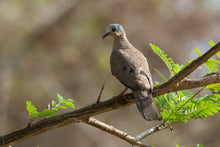The Blue-spotted Wood Dove (Turtur afer) is a species of bird in the Columbidae family. The Blue-spotted Wood Doves (Turtur afer) – also known as Abyssinian or Senegal Blue-spotted Wood Doves, Metal-spotted Wood Doves, Red-billed Wood Doves, Red-billed Wood Doves or Sapphire-spotted Wood Doves– are widespread in a belt across Africa just south of the Sahara Desert. These wood doves are closely related to the similar Emerald-spotted Wood Doves, Turtur chalcospilos and Black-billed Wood Doves,Turtur abyssinicus – all of which have partly overlapping ranges, but don’t appear to interbreed.
Description: Blue-spotted Wood Doves are small plump pigeons that measure 8.7 inches (22 cm) in length and weigh about 2.3 oz (65 grams).The head is grey, with a reddish bill. The back, wings and tail are pale brown and the throat is grey. There are two dark bands across the lower back and tail. The folded wings have distinctive dark glossy patches that can look either black or bluish, depending on the light conditions.The legs and feet are red, and the eyes are brown.Flight: Their flight is quick and characterized by regular beats and occasional sharp flicks of the wings; and they generally fly low. In flight, the chestnut markings in the underwings are visible.Gender ID: Males and females look alike. Juveniles are duller than adults. They are scaly below and lack the wing spots.
Breeding: Pairs are monogamous, establishing firm bonds that last a lifetime. They build flimsy stick nests in the branches of trees (often acacias) or bushes making sure that the nests are well hidden in dense green foliage. The average clutch consists of two cream-colored eggs. The parents take turn in incubating the eggs for about 13 – 17 days to hatching and the nestlings fledge (leave the nest) about 2 weeks later. Pairs raise their young jointly to independence.
Diet: Blue-spotted Wood-Dove mostly feed on various seeds, fallen fruits and insects such as butterflies, bees, wasps, locusts and ants. Most foraging occurs on the ground or low down in the shrubs.




